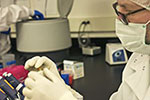Anthropologist discovers clues to first Americans

For more than a decade, WSU molecular anthropologist Brian Kemp has teased out the ancient DNA of goose and salmon bones from Alaska, human remains from North and South America and human coprolites—ancient poop—from Oregon and the American Southwest.
His aim: use genetics as yet another archaeological record offering clues to the identities of ancient people and how they lived and moved across the landscape.
As head of the team studying the DNA of Naia, an adolescent girl who fell into a Yucatan sinkhole some 12,000 years ago, he has now helped illuminate the origins of the first people to inhabit the Americas and their possible connection to native people today.
“It’s incredible to make such a discovery,” said Kemp, an associate professor in WSU’s Department of Anthropology. “It is an honor to be able to use the skills I have acquired to address classic questions about the entrance of humans into the Americas.”
Find out more about this breakthrough research at WSU News
Other sources:
Smithsonian
CBS News
Heritage Daily
The Spokesman-Review
The Yakima Herald-Republic
Science 2.0
The Seattle Times
Archeology News Report
Yahoo News
Red Orbit


